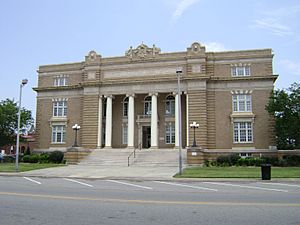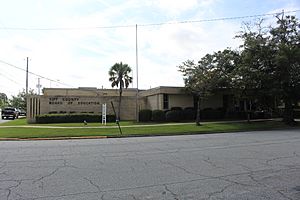Tift County, Georgia facts for kids
Quick facts for kids
Tift County
|
|
|---|---|

Tift County Courthouse, (Built 1912), Tifton
|
|

Location within the U.S. state of Georgia
|
|
 Georgia's location within the U.S. |
|
| Country | |
| State | |
| Founded | August 17, 1905 |
| Named for | Nelson Tift |
| Seat | Tifton |
| Largest city | Tifton |
| Area | |
| • Total | 269 sq mi (700 km2) |
| • Land | 259 sq mi (670 km2) |
| • Water | 9.9 sq mi (26 km2) 3.7%% |
| Population
(2020)
|
|
| • Total | 41,344 |
| • Density | 160/sq mi (60/km2) |
| Time zone | UTC−5 (Eastern) |
| • Summer (DST) | UTC−4 (EDT) |
| Congressional district | 8th |
Tift County is a county located in the south central portion of the U.S. state of Georgia. As of the 2020 census, the population was 41,344. The county seat is Tifton.
Tift County comprises the Tifton, Georgia micropolitan statistical area.
Contents
History
The county was created on August 17, 1905, and is named for Henry Harding Tift, who founded Tifton in 1872. Tift purchased about 65,000 acres of virgin pine timberland there in the Wiregrass Region of South Georgia, and established a sawmill and a village for his workers. Tift eventually expanded into turpentine and barrel-making operations, and turned his barren timberlands into farms for cotton, corn, livestock, fruit, tobacco, pecans and sweet potatoes. When the Georgia Southern and Florida Railway intersected the Brunswick and Western Railroad near Tift's mill in 1888, the settlement was connected to Atlanta and became a boom town. It was incorporated as Tifton by the Georgia Legislature in 1890.
Tift provided employment and financial growth opportunities for his flourishing market center by founding the Tifton Cotton Mill, the Bank of Tifton, and other types of businesses in which he had a leading interest. These included fruit growing, groceries and general merchandise, cottonseed oil, lumber, brick and stone, and several railroads, all essential for the development of a region. Tift also established a model farm north of town and donated a large parcel of acreage for an agricultural experiment station; these enterprises led eventually to the development of Abraham Baldwin College and the Coastal Plain Experiment Station in Tifton.
Tift's civic commitment was most evident in his donation of lands for churches (Methodist, Baptist, and Episcopal) and Fulwood Park, and in his decades of service as a city councilman and mayor. Through a variety of business and civic undertakings, Tift contributed significantly to the economic and social development of south central Georgia. Though a captain of industry, agriculture, and finance, he is best remembered for his civic service and generosity.
Tift County was created on August 17, 1905, by an act of the General Assembly. Because Georgia law in 1905 did not allow a new county to be named after a living person, the legislature voted to name Tift County after Nelson Tift of Albany, Georgia, who was an uncle of Henry Harding Tift.
In 2013, John Edward (Edd) Dorminey a native of Tifton, author and historian drafted resolutions and presented them to the Tifton and Tift County Commissions which were passed unanimously. Soon after with assistance from Representative Jay Roberts the Georgia House of Representatives and the Senate voted to approve the submitted resolution establishing the naming of Tift County after its rightful founder, Henry Harding Tift.
Geography
According to the U.S. Census Bureau, the county has a total area of 269 square miles (700 km2), of which 259 square miles (670 km2) is land and 9.9 square miles (26 km2) (3.7%) is water.
The western portion of Tift County, roughly west of Interstate 75, is located in the Little River sub-basin of the Suwannee River basin. The county's southeastern third, from north of Tifton heading southeast, is located in the Withlacoochee River sub-basin of the same Suwannee River basin. The northeastern portion of the Tift County, east of Chula, is located in the Alapaha River sub-basin of the same larger Suwannee River basin.
Major highways
Adjacent counties
- Irwin County (northeast)
- Berrien County (southeast)
- Cook County (south)
- Colquitt County (southwest)
- Worth County (west)
- Turner County (northwest)
Communities
Cities
Census-designated places
Unincorporated communities
Demographics
| Historical population | |||
|---|---|---|---|
| Census | Pop. | %± | |
| 1910 | 11,487 | — | |
| 1920 | 14,493 | 26.2% | |
| 1930 | 16,068 | 10.9% | |
| 1940 | 18,599 | 15.8% | |
| 1950 | 22,645 | 21.8% | |
| 1960 | 23,487 | 3.7% | |
| 1970 | 27,288 | 16.2% | |
| 1980 | 32,862 | 20.4% | |
| 1990 | 34,998 | 6.5% | |
| 2000 | 38,407 | 9.7% | |
| 2010 | 40,118 | 4.5% | |
| 2020 | 41,344 | 3.1% | |
| 2023 (est.) | 41,554 | 3.6% | |
| U.S. Decennial Census 1790-1880 1890-1910 1920-1930 1930-1940 1940-1950 1960-1980 1980-2000 2010 |
|||
| Race | Num. | Perc. |
|---|---|---|
| White (non-Hispanic) | 22,189 | 53.67% |
| Black or African American (non-Hispanic) | 12,049 | 29.14% |
| Native American | 56 | 0.14% |
| Asian | 650 | 1.57% |
| Pacific Islander | 2 | 0.0% |
| Other/Mixed | 1,179 | 2.85% |
| Hispanic or Latino | 5,219 | 12.62% |
At the 2020 United States census, there were 41,344 people, 15,144 households, and 10,703 families residing in the county.
Education
Tift County School District operates public schools.
See also
 In Spanish: Condado de Tift para niños
In Spanish: Condado de Tift para niños


